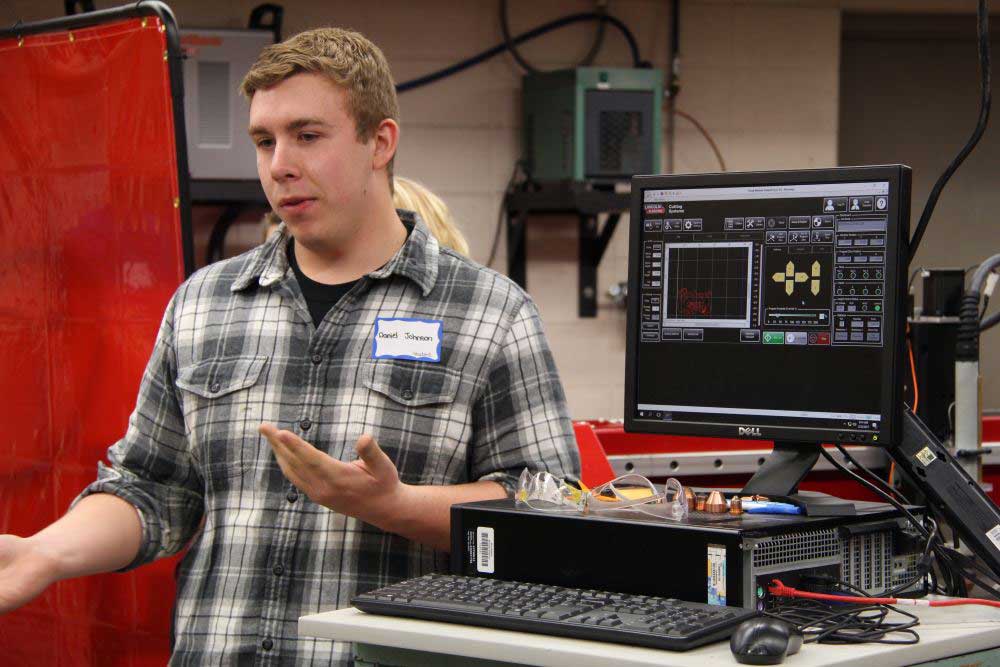Waukesha West Showcases New Equipment For Precision Welding
Posted on: February 6, 2019

Daniel Johnson, a second-year welding student at Waukesha West, discusses how he and his peers built the plasma cutter water table. Photo courtesy of the Waukesha School District.
A Cutting-Edge Learning Opportunity
A group of Waukesha West High School students Wednesday morning unveiled a powerful piece of equipment that school and business officials are touting as a significant step toward addressing the skills gap.
Waukesha County business, government and educational officials convened at West for a showcase of the school’s newly-completed plasma cutter and water table, equipment used in precision welding fabrication.
Funding for the equipment came in partnership with area businesses, including Weldall Manufacturing, Burrie Enterprises, Aries Industries and Generac Power Systems. The financial partnership was also paired with training, as Weldall and Waukesha County Technical College representatives helped guide the students in their use of the new technology.
That kind of school-industry partnership, Superintendent Todd Gray said, will help grow the Waukesha School District’s MADE (Manufacturing, Automotive, Design and Engineering) program into the “best skills gap program in the state.”
“We’re heading in that direction,” Gray said.
Gray said the effort will have multiplicative effects in the region.
“Creating skills employees brings businesses to this area,” he said. “Businesses locate where there’s skilled labor. More skilled labor means a better economy … And strong economy means strong schools.”
Daniel Johnson, a second-year welding student at West, was among a group of students to build the table. Given blueprints drafted by a previous group of students, Johnson and his peers received the parts for the table at the beginning of the school year.
“From there, we had to look at the plans, come up with jigs to hold the metal in place so everything was measured out right, because the parameters of the table had to be in tolerance of a 32nd of an inch, so it’s a very small error range that we had,” he said.
Then, it was a lot of welding, measuring, grinding and more welding — a highly meticulous process, Johnson said.
“We knew everything had to be airtight because if it wasn’t the table would fail and we wouldn’t be able to actually cut,” he said.
Johnson said he and his peers spent many afternoons after school working on the project. His motivation was knowing it would be used for years to come.
“I wanted to get it done because I wanted to use it, but it’s also something cool that later on in my life I can say ‘That table at West that kids are going to be using — I built that,’” he said. “It’s something cool I can say I did for my school.”
Need for Skilled Workers
Now with the table installed, Johnson said he and his classmates have enjoyed learning how to cut various items — from car parts to metal signs — and are benefitting from being trained by industry professionals.
“We’re new to the technology — we’re definitely learning as we go,” he said. “So it’s really great to have these sponsors to help us along the way with any problems we have, especially WCTC because they have a table that’s exactly like ours.”
While West High School teacher Fred Schroedl, who’s previously worked in Milwaukee schools, noted a national decline in vocational opportunities for high school students, he said efforts like MADE are important steps in stemming that tide.
And the need now is significant, he said. Since the economic downturn in the 1980s — combined with an increased push for high school graduates to attend universities — hands-on opportunities in school related to the trades have decreased. But with a highly skilled workforce retiring in large numbers, he said, there’s major demand for new labor.
Now, he said, it’s up to businesses and schools to partner together to offer training opportunities for students.
“I’m optimistic — I think it’s a pretty big hurdle we have to overcome, but if people stay at the table and remember where they came from and even when times get a little tough, they have to remember where they got their start and reach their hand out and give the handout that gave them a hand up,” Schroedl said. “And when we do that, you see things like today happen.”
